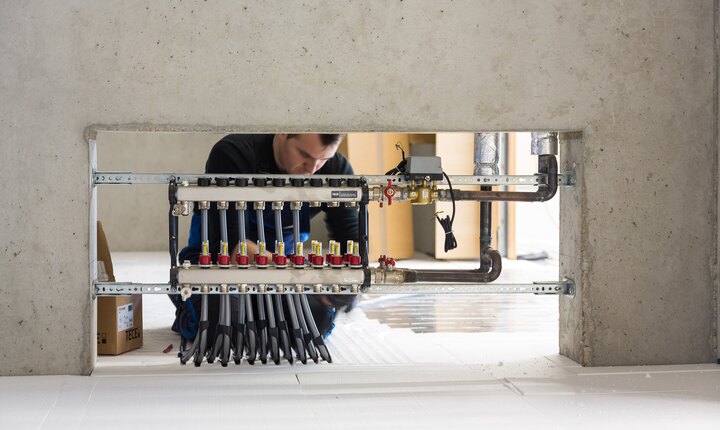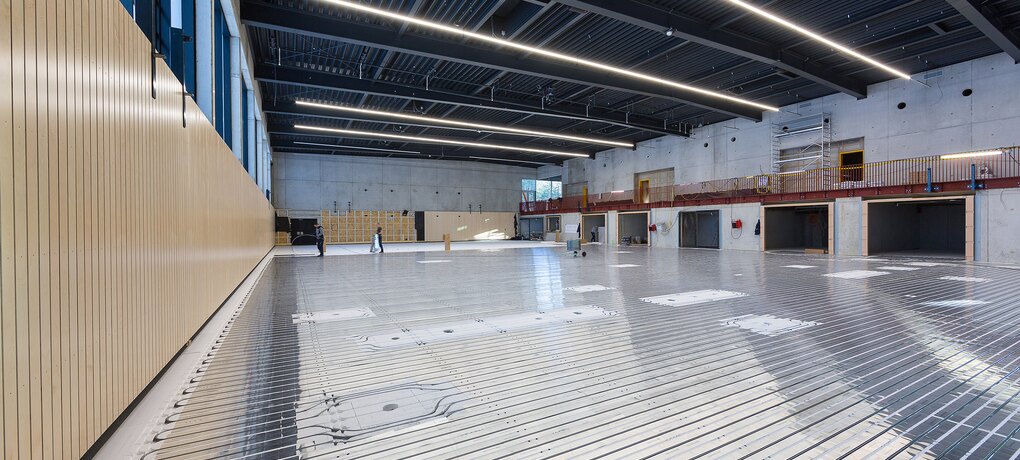
Underfloor heating systems are the preferred solution in sports halls
Indoor sports have special requirements for the floors of sports facilities, which are met by appropriate floor constructions. Underfloor heating is always the ideal solution for the different variants. However, planners and installers need to consider certain special features. This article provides a general guideline and goes into detail using the new Zweifeld sports hall in Coswig near Dresden as an example.
Depending on the type of use, special requirements are placed on the floors of sports and gymnastics halls that go beyond durability and wear resistance – think of transporting gymnastics equipment. This involves physical properties such as ball rebounding, without which some ball games are not even possible. So what is required are defined floor strain properties that are also easy on the athletes' joints and reduce the risk of injury. The requirements are currently specified by DIN 18032 and, for sports hall floors, specifically by DIN V 18032-2.
For various reasons, underfloor heating is particularly suitable for controlling the temperature in sports halls, and today more than every second sports hall is fitted with this type of system. This is not only down to energy-efficient operation and good ventilation. Other important features include the pleasant surface temperatures for floor sports and the saving of additional enclosures for radiators or air heaters, which also has a positive effect on the aesthetics of the interior.
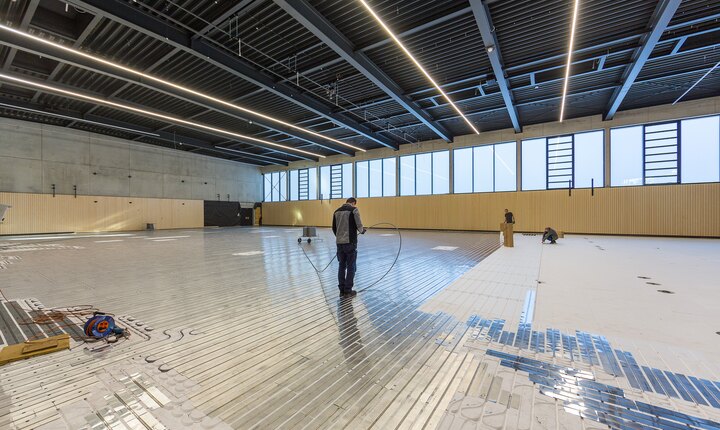
Three fundamentally different types of sports hall floor need to be distinguished in planning, which also place different requirements on the underfloor heating. DIN 18032-2 states the three variants:
- Area-elastic sports floor as a sprung floor,
- Area-elastic sports floor in a sandwich construction,
- Point-elastic and mixed-elastic sports floors in a construction type A with screed and construction type B for dry construction.
The type of sports floor according to the standard is chosen depending on the planned use and the resulting requirements. If the heating is to be provided by underfloor heating, the specialist planner determines system temperatures, the basic structure, installation distances and control equipment in a design calculation, on the basis of which the tender documents are prepared.
Three types of sports hall floors
With the area-elastic sports floor designed as a sprung floor, “contact blocks” are placed on the subfloor. These penetrate the thermal insulation. Wooden swing beams are laid on top of the blocks and what is known as a subfloor made of wooden slats is laid perpendicular to them. Then come the load distribution plates followed by the top covering. A cavity is created between the thermal insulation and the subfloor, into which the underfloor heating is to be installed. The problem for the heating engineer is the screws that protrude after installation and are used to connect the subfloor and the load distribution plates. These screws need to completely penetrate the two layers for reasons of strength. The required distance between the heating pipes and the subfloor can of course be planned with sufficient certainty, but the heating engineer must ensure that the pipes rest firmly on the insulation layer – even with pipe loops. For sprung floor constructions, it makes sense to mount the heating pipes with clip rails or staple pins.
For area-elastic sports floors in a sandwich construction, underfloor heating systems with moulded system insulation boards are the most suitable. Elastic layers, pressure distribution modules and the top layer follow towards the top.
A simpler design is the point and mixed elastic sports floor in construction type A with screed and construction type B for dry construction. Here, the underfloor heating is installed in the dry construction variant with dry screed panels or for a screed floor. The sports floor builder then lays the point-elastic/mixed-elastic sports floor on top of this. It should be noted that as a rule, in view of often very tight schedules, the dry construction variants offer advantages.
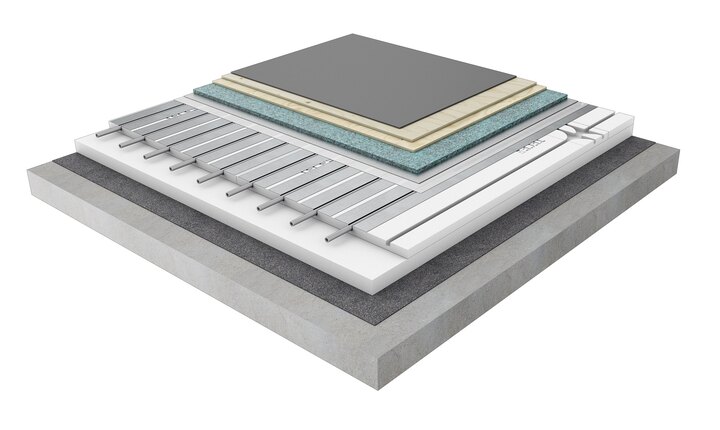
Spitzgrund sports hall in Coswig
The new Spitzgrund sports hall in Coswig near Dresden was to be fitted with an area-elastic sports floor in a sandwich construction with underfloor heating. The owner-managed installation company Rühle Bad & Heizung (www.ruehle-coswig.de) with father Mathias Rühle and son Fabian Rühle, both as managing directors, were interested in this project. The manufacturer of the radiant heating system indicated in the invitation to tender was not one of the preferred suppliers of the company, which likes to work together with TECE, the specialist for sanitary technology and pipe systems, for various product groups. So the Rühles tried to turn this invitation to tender around to an equivalent system solution from Emsdetten – a fully customary and, from the point of view of the company, also legitimate procedure.
With this goal in mind, the heating construction company contacted TECE product manager Andreas Lösing. Together, the documents were reviewed and an alternative solution was developed that also offered advantages during installation by further optimising the heating circuits and positioning the manifolds differently. In the end, the proposal was successful.
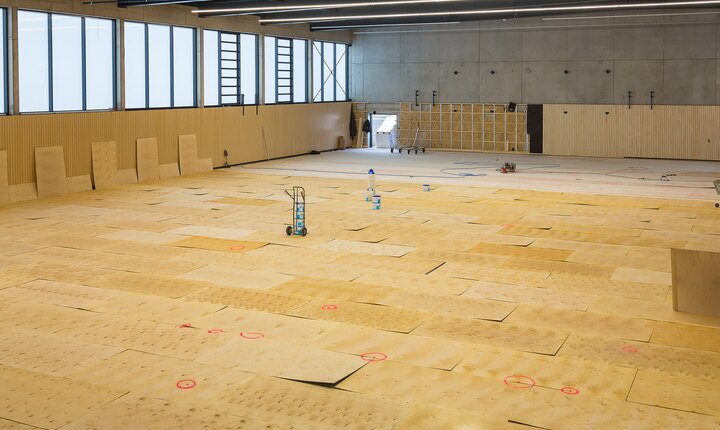
As a result, the system was constructed with the alternative offer for the underfloor heating with Fabian Rühle as site manager. The TECEfloor dry construction system TP 30/16 was installed as the underfloor heating. This consists of the TP 30/16 dry construction board with 30 mm thick polystyrene and heat conduction profiles to accommodate 16x2.0 mm heating pipes. Aluminium and steel are the material options for the heat-conducting profiles, with aluminium being chosen for the sports hall in Coswig because of its significantly better thermal conductivity. The heat-conducting profiles have predetermined breaking points that allow them to be processed on site without tools. This example shows the detail to which this complete system is optimised for quick and easy installation, which is often crucial, especially for larger projects.
Sports floor installation
After laying the underfloor heating, the next step for area-elastic sports floors in a sandwich construction is to lay a foil and then a 0.6 to 0.8 mm thick steel sheet for load distribution, as Andreas Lösing explains. In Coswig, this is followed by a 15 mm thick PUR composite foam board for damping followed by two layers of plywood, which are laid with staggered joints. The final layer is the linoleum floor with a 4 to 5 mm thickness.
This type of floor construction has consequences for the design of the radiant heating. Lösing comments: “Above all, the PUR composite foam board hinders the transfer of heat due to its high thermal resistance. To compensate for this, the underfloor heating must be operated at higher system temperatures – the rule for designing this type of floor construction is to allow for flow temperatures of up to 70°C. This is also the temperature that is often specified as the maximum permissible for sports hall floors, so that the materials retain the required properties over their service life, i.e. above all do not become brittle.” So in this case, the design differs considerably compared to underfloor heating systems in normal buildings, where the supply temperatures are in the 30 to 40°C range.
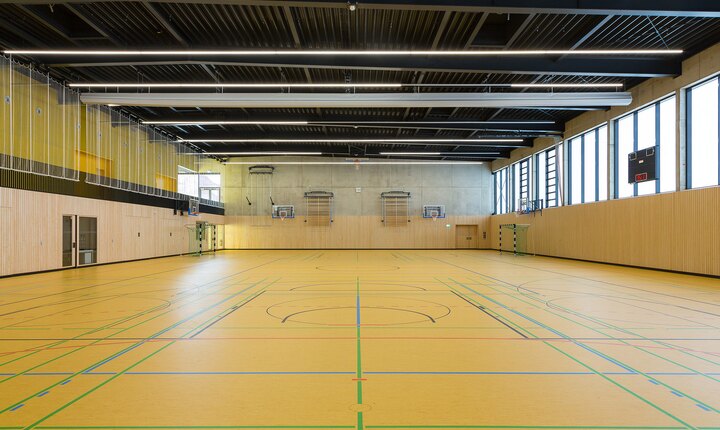
Spitzgrund sports hall facts and figures
The entire building is supplied by district heating. As well as the hall floor, the ancillary rooms have also been fitted with underfloor heating systems from Emsdetten. In total, the heated floor areas in the ancillary rooms comprise 500 m2, with around 2700 m of pipe being processed here, according to the planning documents. The area of the sports floor in the hall is 1096 m2 and here around 7000 m of pipe had to be laid at 15 cm intervals. These figures already show that the pipes under the sports floor are laid more densely than in the screed floors of the adjoining rooms in order to compensate for the insulating effect of the PUR composite foam board. Four TECEfloor stainless steel manifolds, two of which are installed in each of the two equipment rooms, supply 36 heating circuits in the hall floor. Andreas Lösing: “With sports floors and industrial panel heating systems, it is often worth critically checking the installation proposals of the planning software a second time, in order to optimise the pipe layout and hydraulics from an installation perspective.
The software tends to be conservative in this respect, which is fundamentally the right approach, because you can't plan everything manually. In this case, however, it could be approved a bit.”
